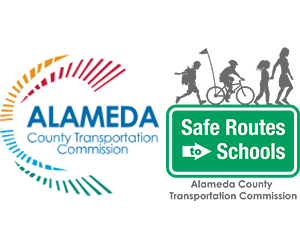Our Mission

Our mission is to strive for Healthy Kids, Safer Streets, Strong Communities. The Alameda County Safe Routes to Schools Program works in schools across Alameda County to develop school travel programs that make sense for their communities.
- We teach kids the basics of walking and biking safely.
- We make walking and biking to school fun with special events.
- We help communities identify traffic investments to make their communities safer.
We began in 2006 as a grant-funded pilot program in Oakland, California. The pilot was implemented by TransForm, a local non-profit organization. Today, we serve over 300 public schools in Alameda County, teaching students from elementary school to high school the joys and benefits of choosing active and shared transportation options to get to school. Our program is managed, administered and funded by the Alameda County Transportation Commission and is implemented by a fantastic team of Safe Routes to Schools experts and professionals working together to fulfill our mission for healthy kids, safer streets, and strong communities.
Equity
We consciously plan and operate our program with equity in mind. We are committed to creating Healthy Kids, Safer Streets, Strong Communities for all students in Alameda County, and we understand that many under-resourced communities—including communities of color and low-income and indigenous communities, along with recent immigrants or people with disabilities—are more likely to live in places with fast-moving cars, poor pedestrian and bicycle infrastructure, and threats from crime and violence that would discourage walking or bicycling. We also know and acknowledge that the benefits of walking and bicycling, such as increased physical activity, cleaner air, and reduced transportation costs, can directly address the inequities that under-resourced communities often feel.
Striving toward equity, our program launched the Access Safe Routes Pilot Program in 2017 with the main goal of increasing participation in our program by under-resourced schools. The pilot provided highly tailored, face-to-face support to participating schools to help identify and address the barriers to increased use of active and shared modes. At the same time, school site coordinators worked with the schools to build internal leadership that would result in a more sustainable program in the long term. Program staff also tested strategies to understand and address the needs of under-resourced schools to help these under-resourced schools successfully implement an SR2S program. In 2019, we were awarded a $3.7 million Active Transportation Program grant to expand this program to 70 schools that have never received our programming.
Putting Safety First
Student safety is every parent’s first priority. Everything we do at the Alameda County Safe Routes to Schools program starts with safety. This includes safety when walking, biking, rolling, or driving. This also includes safety for elementary, middle, and high school students, as well as for parents and members of the community.
Creating Healthier Kids and Communities
We find ways to get kids moving that fit into families’ busy schedules. Walking and biking isn’t just fun, it’s also good for your brain; studies show active kids do better in school. When kids walk or bike to school, they’re able to pay attention, learn more, and do better in class.
Walking and biking also creates healthier, stronger communities. Walking to school together is a chance to meet your children’s friends and their parents, get to know your neighborhood, and teach your kids how to be street smart and safe. Sharing the responsibility of getting our children to school is a great way to build stronger communities and save time for us all.
Improving Road Infrastructure
We work to make the streets around our schools safer for students and other road users. We conduct “walk audits” that bring together parents, city or county planners and engineers, neighbors, traffic safety officers and elected officials to better understand how changes to the streets around a school can make them safer. We also work with local public works departments to ensure that needed improvements are made.
